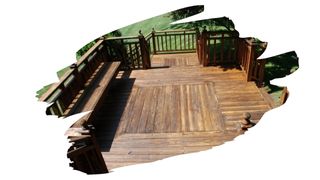Wood is already expensive enough. But, pressure treated wood costs even more. And that increase in price can add thousands to the cost of installing a deck.
But, can you save money by simply using untreated wood for your outdoor projects instead?
Well, in this post, you will discover what pressure treatments actually do to wood — and whether they’re really as dangerous as the reputation that follows them. You will also learn why non pressure treated wood is rarely used for outdoor building construction.
And keep reading to discover what you can do to protect your stack of untreated wooden planks from outdoor weathering.

This post may contain affiliate links to products that we receive a commission for (at no additional cost to you). Learn more here.
What Does Pressure Treatment Actually Do To Wood?
Pressure treated wood is a process that saturates lumber with water-soluble chemical wood preservatives. These preservatives are like a kind of fungicide, because they help prevent wood rot bacteria from growing on timber.
As a result, pressure treatment makes wood much more resistant to decay. But, it doesn’t otherwise strengthen wood.
And pressure treated wood, (that is used on outdoor structures), will often still need a top coating sealant on it.
Is Pressure Treated Wood Really All That Toxic?
It mostly depends on the specific chemicals used to treat it.
Some older treated timbers are saturated with very harsh chemicals such as arsenic-riddled ‘Chromated Copper Arsenate’ (CCA). However, these particular types of pressure treated wood are banned from being used any where near residential properties.
Nevertheless, there are farm-safe types of treated wood that can be used around a residential property. For example, Alkaline Copper Quaternary (ACQ) treatments contain Copper Oxide.
It’s copper component also turns ACQ treated wood the color green. Which is why this treated wood is often referred to as ‘green-treated’ wood.
Now, ACQ treated timber has been approved by the E.P.A. (U.S. Environmental Protection Agency) for use around a residential property. So, it can be used for making garden beds, or decking.
Related Post: Should You Use Cinder Blocks (Vs Wood) For Your Raised Bed?
I Still Don’t Want To Take A Chance. Can I Use Untreated Wood Outside Anyway?
This is yet another ‘it mostly depends’ situation.
You see, wood meant for outdoor construction, (especially if it has prolonged ground contact), will often be pressure treated. Those wood preserving chemical treatments can more than double the longevity of timber, (compared to untreated wood).
However, if your decking is made from a very rot-resistant wood, such as Teak wood, then it can survive without any special treatments.
Related Post: Can You Apply Lemon Oil On A Teak Wood Surface?
Naturally rot-resistant timbers, such as Teak wood or White Oak, have characteristics that prevent their wood fibers from absorbing moisture. This, in turn, means that these wood types often don’t become damp enough for wood rot to grow in them.
But, you should also pair these rot-resistant lumbers with a weatherproofing sealer. A quality exterior sealant will not only waterproof wood, it’ll also prevent UV-damage as well.
Can I Use Regular White Wood For A Deck? If that whitewood is Douglas Fir, (a popular whitewood used for construction framing), then you can.
Related Post: What Is The Best Treatment For Douglas Fir Porch Decking?
So I Can Go Ahead And Use Non Pressure Treated Wood Outside?
Well, broadly speaking, when it comes to the highest quality rot-resistant lumbers — such as Rough Oak — you can. You do not need to treat it.
Related Post: Is Pressure Treated Wood Better For A Trailer Deck?
However, no building contractor worth their salt would willingly use untreated wood outdoors. And, they certainly would not use untreated wood on structures that will have prolonged ground contact.
Fact of the matter is, moisture on the ground will seep and saturate wood. And that will speed up the rate of decay, in even the most durable of lumbers.
For example, untreated White Oak wood can rot and decay away in less than half the time, if it has direct ground contact.
So, if you’re planning on building that decking directly on the ground, then only use pressure treated wood.
Related Post: Can You Really Use Untreated Oak For Raised Beds?
Is There A Way To Safely Treat Non Pressure Treated Wood Myself?
You can absolutely safely ‘treat’ wood yourself. This typically involves saturating wood with a garden-safe wood preserver.
A penetrating wood preserver will soak into wood, coat wood fibers, and prevent wood from decaying.
But, a penetrating wood preserver is only meant to be a base coat. So, it will need an exterior top coating sealer to finish things off.
If this sounds good to you, then check out Cuprinol’s Clear Wood Preserver. Cuprinol’s eco-friendly clear preservative is odorless, garden-safe, and even pet-safe.
It is simple, quick and easy to apply. And it is designed for exterior use — although it can also be used on interior wood too.
You can discover more about Cuprinol’s Wood Preserver over on their website.
To Wrap Up, Here Are The 3 Key Takeaways From This Post…
- 1). Pressure treatment infuses wood with rot-resisting chemicals.
- 2). And that is why wood, that’s meant for outdoor projects, often comes pressure treated.
- 3). Even naturally rot-resistant wood types, such as White Oak, will decay away in half the time if left untreated.
References:
Treated Wood In The Landscape | Home & Garden Information Center

